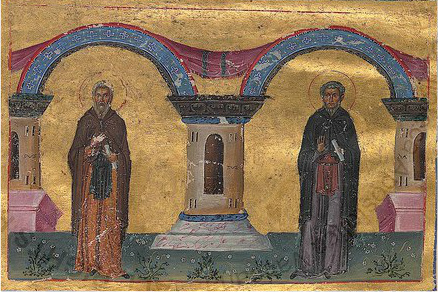Saint Prokopios lived during the VIII century in the region of Dekapolis, east of the Sea of Galilee. Forsaking the vainity of this world, Prokopios was tonsured in a certain monastery, where he labored for his salvation, devoting himself to a life of prayer and fasting. As he grew experienced in ascetical labors, he was adorned with virtue and purity of soul, so that other ascetics began to notice him. Meanwhile, about this time, the heresy of iconoclasm appeared. Prokopios was distressed by the policies of the wicked Emperor Leo the Isaurian, who regarded the Holy Icons as idols, and those who venerated them as idolaters.

The righteous Prokopios, together with other zealots of Orthodoxy, fought against the wicked heresy of the iconoclasts. He refuted their mindless madness and defeated them by declaring that Orthodox Christians do not worship icons, we venerate them, and that veneration passes to the original prototype. This brought upon him the wrath and disfavor of the Emperor. At his command, Saint Prokopios was arrested and subjected to cruel torments: he was flogged, beaten with rods, and raked with iron claws, and then was thrown into a dank dungeon. There Saint Prokopios and Saint Basil (February 28), his co-struggler in the monastic liife, languished until the death of Emperor Leo, when the Holy Confessors were released.
Saint Prokopios the Decapolite spent the remainder of his life in peace, guiding many on the path of virtue and salvation. He reposed at an advanced age, around the year 750.
Saints Procopius and Basil, fellow ascetics, lived about the middle of the eighth century, during the reign of Leo the Isaurian (717-741), from whom they suffered many things for the sake of the veneration of the holy icons. They ended their lives in the ascetical discipline.
This saint was from Decapolis by the Sea of Galilea, for which reason he was called the Decapolite. In his youth he devoted himself to a life of asceticism and accomplished all the prescribed labors by which the heart is purified and the spirit is elevated to God. When the wicked Leo the Isaurian began his persecution of the icons and their venerators, Procopius rose up in their defense. He showed that the veneration of icons is not idolatry, for Christians know that by bowing down before icons they are bowing down not to lifeless matter, but to living saints who are depicted in the icons. Because of this, Procopius was arrested, brutally tortured, flogged and scrapped with an iron brush. When the wicked Emperor Leo was slain in the body–for he had lost his soul earlier–icons were restored in the churches, and Procopius returned to his monastery, where he spent the remainder of his days in peace. In his old age he was translated to the Kingdom of God. There he gazes with joy upon the living angels and saints, whose images on icons he honored on earth. He died peacefully in the ninth century.
Source and photos: vema.com.au















